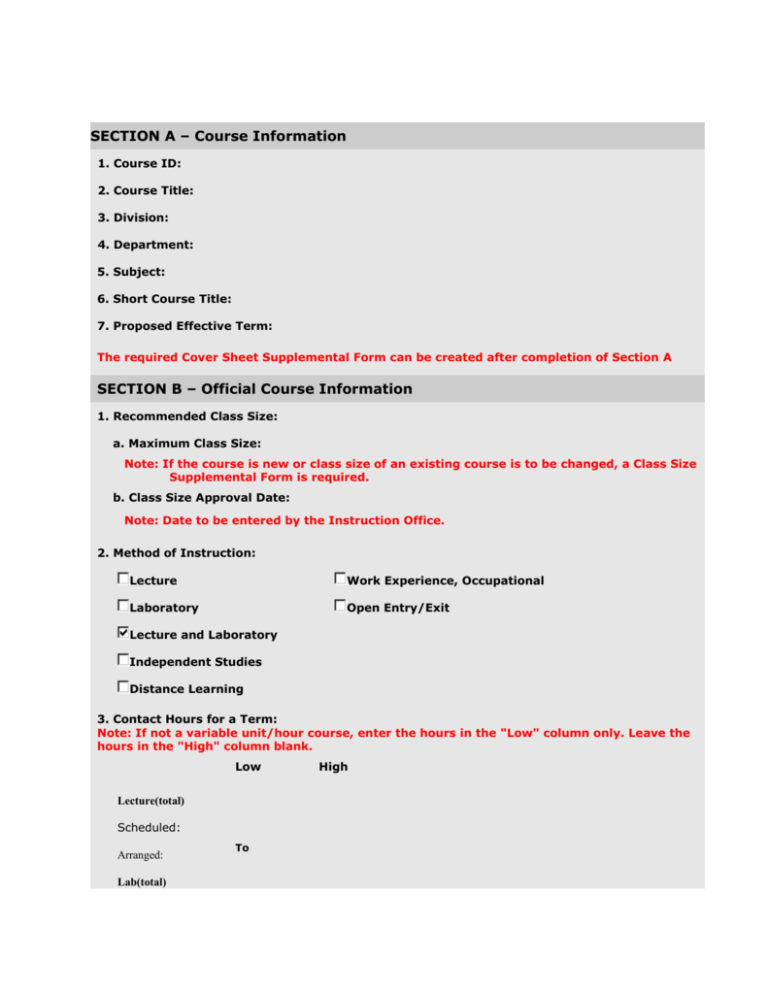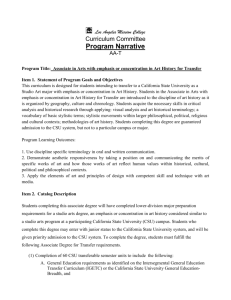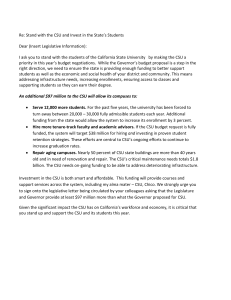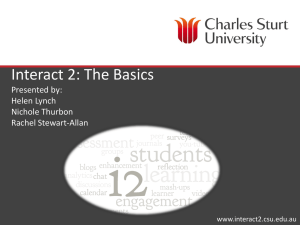Blank Course Outline - Mt. San Antonio College
advertisement

SECTION A – Course Information 1. Course ID: 2. Course Title: 3. Division: 4. Department: 5. Subject: 6. Short Course Title: 7. Proposed Effective Term: The required Cover Sheet Supplemental Form can be created after completion of Section A SECTION B – Official Course Information 1. Recommended Class Size: a. Maximum Class Size: Note: If the course is new or class size of an existing course is to be changed, a Class Size Supplemental Form is required. b. Class Size Approval Date: Note: Date to be entered by the Instruction Office. 2. Method of Instruction: Lecture Work Experience, Occupational Laboratory Open Entry/Exit Lecture and Laboratory Independent Studies Distance Learning 3. Contact Hours for a Term: Note: If not a variable unit/hour course, enter the hours in the "Low" column only. Leave the hours in the "High" column blank. Low Lecture(total) Scheduled: Arranged: Lab(total) To High To Scheduled: Arranged: Lab/Lecture Parity? Yes No Does this course have lab parity? If not, are you going to apply for lab parity? Yes No To Activity(total) Scheduled: Arranged: Clinical: To To To Total Hours: Scheduled: Arranged: To To To 4. Credit Units: Note: Units of credit are based on: 1 Unit of credit per eighteen (18) hours of lecture contact hours for a term 1 Unit of credit per fifty-four (54) hours of lab, activity or clinical contact hours for a term 5. Taxonomy of Programs (TOPS) Information: a. TOPS Code and Course Program Title: b. Course Control Number: (To be entered by the Instruction Office Only.) 6. SAM Priority Code: [Select One] A. Apprenticeship B. Advanced Occupational C. Clearly Occupational D. Possibly Occupational E. Non-Occupational Courses offered to apprentices only. Courses taken in the advanced stages of an occupational program. Each “B” level course must have a “C” level prerequisite in the same program area. Courses taken in the middle stages of an occupational program. Should provide the student with entrylevel job skills. Courses taken in the beginning stages of an occupational program. 7. Please place this course into the appropriate discipline by selecting from the drop down list. The discipline placement indicates what preparation is needed to teach the course. Discipline faculty may place their courses into more than one discipline as appropriate: 8. General Course Information a. Course Credit Status: b. State Transfer Code: c. State Classification Code: d. Basic Skills Status/Level: e. Sports/Physical Education Course: Yes ( Only check here if the course is a physical education course.) f. Grading Method: g. Number of repeats allowed: Note: If course is repeatable, complete the Repeatability Supplemental Form. h. Please provide cross listed course if applicable: 9. Course Preparation Note: If this course has a new requisite, complete the Content Review Supplemental Form. a. Prerequisite b. Co requisite c. Advisories d. None 10. Course Special Designators: Do not edit this text box. Use the 'Add'/'Remove' command buttons above. 11. Course Program Status: These buttons are only active when the course reaches Stage 5 in WebCMS. Program Applicable Stand-alone 12. Funding Agency Category: Not Applicable Primarily developed using economic development funds Partially developed using economic development funds SECTION C – Transfer Status (CSU) Supplemental Form before submitting course for approval. CSU Transferable CSU Approval Date: (mmddyyyy) UC Transferable UC Approval Date: (mmddyyyy) Note: CSU Transfer Status must be obtained prior to submitting a request for UC Transfer Status to the UC Chancellor. SECTION D - General Education Request Mt. San Antonio College and CSU General Education course approval are submitted to the Educational Design GE and BL Subcommittee for approval. 1. The Articulation Officer submits the course directly to the CSU Chancellor for approval. 2. Upon receiving approval, the course is approved for the Mt. SAC Associate Degree GE and placed in the area(s) CSU approval indicate(s). Requesting approval for inclusion on Mt. SAC and CSU General No Yes Education List? Note: If requesting approval for inclusion on the General Education List, the General Education Course Evaluation Supplemental Form must be completed before submitting course for approval. If request is approved, the remainder of Section D will be completed by the Instruction Office. 1. Mt SAC General Education Applicability: GE Approval Date : (mmddyyyy) 2. CSU General Education Applicability (Requires CSU approval): CSU Approval Date: (mmddyyyy) 3. IGETC Applicability (Requires CSU/UC approval): IGETC Approval Date: (mmddyyyy) SECTION E - Course Content 1. Course Descriptions a. Catalog Description: (Write a clear, concise course description, summarizing the course content. Include major goals of the course, scope, requirements for successfully completing the course, and any unusual aspects of the course.) b. Class Schedule Description: Yes No Is a course description to be printed in the Class Schedule? (If yes, write one or two sentences condensing the catalog description for the prospective student. Does not require as much detail as the catalog description. Limited to 130 characters, including spaces.) 2. Course Outline Information In courses that include lecture and laboratory, the topical outlines should be separate and distinct, each specific and appropriate to the activities to be conducted. a. Lecture Topical Outline: (The lecture topical outline should provide a detailed record of the content of the course.) b. Lab Topical Outline: (The lab topical outline should reflect the activities in lab.) 3. Course Measurable Objectives: (Measurable course objectives should identify expected outcomes: specific, observable student actions – what the student should be able to do, know or feel as a result of taking this course. A majority of objectives should reflect critical thinking, i.e. application, analysis, synthesis, and evaluation. Course objectives should relate directly to methods of evaluation) Provide a minimum of five (5) course measurable objectives: . 4. Course Methods of Evaluation: (Methods of evaluation should relate directly to measurable course objectives. They indicate the kind of assignments or performance activities designed for a course to assess student learning. Each course must list either substantial writing assignments (category 1) OR computational / non-computational problem solving demonstrations (category 2) if writing assignments are inappropriate (with an explanation of why substantial writing is not appropriate for the course). Activities typically assigned in categories 3 and 4 must also be listed in this section.) Category 1. Substantial written assignments for this course include: If the course is degree applicable, substantial written assignments in this course are inappropriate because: Category 2. Computational or non-computational problem solving demonstrations: . Category 3. Skills Demonstrations: Category 4. Objective Examinations: 5. Sample Assignments: (Assignments should be directly related to the objectives of the course. They should be specific enough to provide real guidance to faculty and clear expectations for students. Descriptions of the type or examples of assignments are required. For example, rather than “term paper” state “term paper comparing and contrasting the social aspects of hunting tactics of two mammal species.” This section must establish that the work is demanding enough in rigor and independence to fulfill the credit level specified. The nature of the assignments must clearly demand critical thinking. Assignments should be adequate to assure that students who successfully complete them can meet the objectives of the course. Appropriate out-of-class work is required for credit courses.) Provide a minimum of three (3) sample assignments: . 6. Representative Text: (List EXAMPLES of textbooks and other data sources and materials, which may be used in this course. Provide author, title, publisher, date of publication, and edition.) If the course is requested to be or is CSU transferable, provide at least one (1) representative text. Representative text is optional for a non-transferable course. a. Book 1: Author: Title: Publisher: Date of Publication: Edition: b. Book 2: Author: Title: Publisher: Date of Publication: Edition: c. Book 3: Author: Title: Publisher: Date of Publication: Edition:








